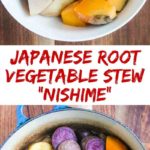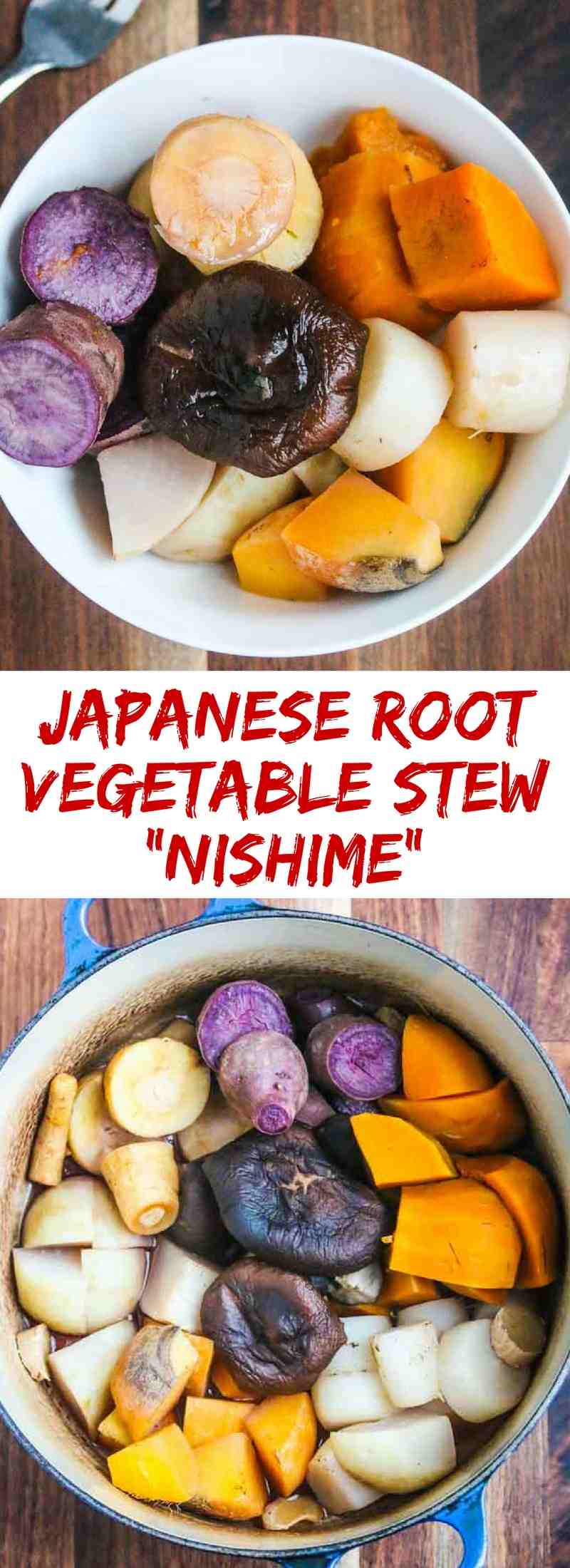Japanese Root Vegetable Stew (Nishime) is an easy, healthy way to enjoy nutritious root vegetables. Nishime is a slow-braised dish that includes a variety of root vegetables. Meat is sometimes added, but the vegetarian version I’m sharing today is one a friend taught me how to make. The simplest recipe for nishime starts with a little water in a pot with a piece of kombu (a type of seaweed) in the center of the pot, surrounded by an assortment of root vegetables and other winter vegetables.
What is Nishime?
Nishime is a method of cooking vegetables that means waterless cooking. Vegetables are cut into large chunks and cooked slowly over low heat. I chose purple sweet potato, daikon, butternut squash, turnips, rutabaga and parsnips, but you can use whatever hard winter vegetables you have on hand.
If you use organic vegetables, scrub the skins and leave them on. Very little liquid is added to the pot, so the steam in the pot cooks the vegetables in their own juices. The vegetables are seasoned with sea salt, soy sauce or a little miso.
According to my friend Angela who invited me to her home to watch her make this simple Japanese root vegetable stew, nishime is a nourishing, healing stew. Angela simply used a piece of kombu and sea salt to season her nishime. Kombu can be found in Asian grocery stores, natural food stores, or online. I recently purchased a large bag of kombu from Maine Seaweed LLC, but I’ve also heard Maine Coast Sea Vegetables and Rising Tide Sea Vegetables (California) are good sources.
Nishime Flavor Additions
When I made this Japanese root vegetable stew, I couldn’t resist using dashi, ginger and dried shitake mushrooms for more flavor. A little miso can also be stirred in. The vegetables are cooked at a low heat, covered, until tender. The result is vegetables that are juicy and tender.
You can thicken the braising liquid in this Japanese root vegetable stew with a little kuzu root starch slurry if you like. Kuzu is supposed to soothe and strengthen the stomach and intestines. Serve with a little soy sauce if you like.
Nishime style vegetables are part of the macrobiotic diet and are believed to give strong, calm energy.
Japanese Vegetable Stew (Nishime)
You can use whatever root vegetables you can find, just be sure to use a variety.
Ingredients
- 1 organic rutabaga cut up
- 1 organic turnip cut up
- 1 organic small butternut squash peeled, seeded, cut up
- 1 small organic daikon radish cut up
- 1 small organic sweet potato cut up
- 3 dried shitake mushrooms
- 3 slices ginger
- 3 cups water or dashi
- 1 3" piece kombu
- sea salt or soy sauce to taste
- miso optional
Instructions
-
Arrange vegetables, mushrooms, and kombu in the bottom of a large pot. Tuck ginger slices between vegetables. Pour dashi on top (enough so there is 1-2" of liquid in the pot) and season with a little sea salt or soy sauce. Bring to a boil, then reduce heat, cover and cook until vegetables are tender, about 25-30 minutes.
Serve with extra soy sauce on the side if you wish.
Recipe Notes
Other vegetables that you might want to try are carrots, burdock, parsnips, cabbage, leeks, or lotus root.
If you like this Japanese vegetable stew recipe, you might also like:
Japanese Braised Kabocha Squash

















What is dashi? Thought you meant it’s waterless cooking.
I love fuss free recipes and this one fits the bill perfectly.
Dashi is a Japanese broth that is made with just water, kombu (seaweed) and bonita (fish flakes). You can use just water too. Very little liquid is in the pot which is why it’s called “waterless” cooking. This cooks at a very low heat.
This is such a beautiful root vegetable stew! I love all the colors! It not only makes me want to eat the stew, but grow all the veggies too!
Thanks Pamela – root vegetables can be so beautiful!
Thanks for the recipe. I wonder if it can be adapted for Instant Pot? Or would the quick cooking not allow the flavors to permeate the veggies?
I think this should work fine in an Instant Pot. Generally speaking, I reduce the cooking time to 1/3 of the regular cooking time when cooking under pressure.
I did it in my Instant Pot – 6 minutes on manual, then after 6 minutes did the steam release.
Great – thanks for sharing!
I made this recipe but with a few modifications, since I am a single person cooking for myself.
I caramelized 1/4 cup of sliced white onion in a large broiling pot with a little pat of butter. I then added 2 cups of water and 1 packet of Japanese powdered dashi granules. I did not have kombu, but I do have dried wakame so I added 2 tablespoons of dried wakame (as it expands quite a lot in liquid and also assists with thickening).
The vegetables I used: carrot, yellow rutabega, celery, kohlrabi, and taro root, along with aromatics (ginger & garlic). I would have liked to add a few dried mushrooms but I did not have any this time.
I made enough for two servings. The first time I tried it with soy sauce; when I have it for lunch tomorrow I will reheat it and try it with a pat of white miso.
Thank you for the wonderful recipe. I enjoyed the simple but flavourful broth and selection of tender-crisp vegetables. I will be making this again as we transition into fall, along with miso soup.
Hi Jen – thanks so much for sharing your modifications – they all sound great!